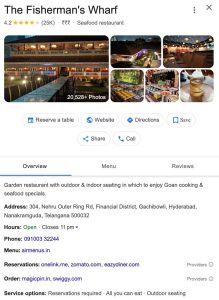
In today’s digital age, local SEO for restaurants is no longer optional—it’s essential. With 46% of all Google searches having local intent, restaurants that fail to optimize for local search risk losing customers to competitors who are more visible online. Whether you’re a small café or a fine-dining establishment, mastering local SEO can help you attract more foot traffic, increase online orders, and grow your business. In this guide, we’ll explore proven local SEO strategies for restaurants, actionable tips, and common mistakes to avoid.
Why Local SEO is Crucial for Restaurants
The Power of Local Search for Restaurants
Did you know that 72% of consumers who perform a local search visit a store within five miles? For restaurants, this means appearing in local search results can directly translate to more customers walking through your doors. Google’s Local Pack—the top three results that appear with a map—is prime real estate for attracting hungry diners. If your restaurant isn’t optimized for local SEO, you’re missing out on a massive opportunity to connect with nearby customers.
Challenges Restaurants Face Without Local SEO
Without a strong local SEO strategy, restaurants face several challenges:
- Getting buried under competitors in search results.
- Losing visibility on platforms like Google Maps.
- Missing out on local customers searching for nearby dining options.
By implementing the right strategies, you can overcome these challenges and ensure your restaurant stands out in local searches.
10 Proven Local SEO Strategies for Restaurants
1. Optimize Your Google My Business (GMB) Profile

Your Google My Business (GMB) profile is the cornerstone of local SEO for restaurants. It’s the first thing potential customers see when they search for your restaurant or related keywords. Here’s how to optimize it:
- Complete Your Profile: Fill out every section, including your name, address, phone number (NAP), website, hours, and menu.
- Add High-Quality Photos: Showcase your dishes, ambiance, and staff to entice customers.
- Choose the Right Categories: Select categories like “Italian Restaurant” or “Café” to help Google understand your business.
- Post Regular Updates: Share events, special offers, or new menu items to keep your profile fresh and engaging.
2. Leverage Online Reviews and Ratings
Online reviews are a critical ranking factor for local SEO. They also influence customer decisions. Here’s how to make the most of them:
- Encourage Reviews: Politely ask satisfied customers to leave reviews on Google, Yelp, or TripAdvisor.
- Respond to Reviews: Thank customers for positive reviews and address negative feedback professionally.
- Monitor Reviews: Use tools like Google Alerts or ReviewTrackers to stay on top of new reviews.
3. Use Location-Based Keywords
Incorporating location-based keywords into your website and content helps Google understand where your restaurant is located. For example:
- Target keywords like “best pizza in [City]” or “family-friendly restaurant in [Neighborhood].”
- Use these keywords in your meta titles, descriptions, and content.
- Create location-specific landing pages if you have multiple branches.
4. Create Locally-Focused Content
Content that resonates with your local audience can boost your SEO and engagement. Consider:
- Writing blog posts like “Top 10 Must-Try Dishes in [City]” or “A Foodie’s Guide to [Neighborhood].”
- Highlighting local events, partnerships, or community involvement.
- Sharing stories about your restaurant’s connection to the community.
5. Build Local Backlinks
Backlinks from local websites signal to Google that your restaurant is a trusted local business. Here’s how to build them:
- Partner with local bloggers or food influencers to review your restaurant.
- Get listed in local directories like Yelp, TripAdvisor, and Chamber of Commerce websites.
- Sponsor local events or charities and ask for a mention on their website.
6. Optimize for Mobile Users
With 60% of Google searches happening on mobile devices, having a mobile-friendly website is crucial. Ensure your website:
- Loads quickly (under 3 seconds).
- Has a responsive design that works on all screen sizes.
- Features easy-to-click buttons for reservations, online orders, or directions.
7. Use Schema Markup for Local SEO
Schema markup helps search engines understand your website’s content. For restaurants, this can include:
- Menu items, reviews, location, and business hours.
- Tools like Google’s Structured Data Markup Helper can simplify the process.
8. Engage with the Local Community
Building relationships with your local community can boost your visibility and reputation. Consider:
- Partnering with local influencers or food bloggers.
- Hosting or sponsoring local events.
- Collaborating with nearby businesses for cross-promotions.
9. Monitor and Analyze Performance
Tracking your local SEO efforts ensures you’re on the right track. Use tools like:
- Google Analytics to monitor website traffic and conversions.
- Google Search Console to track search rankings and fix errors.
- Moz Local or BrightLocal for detailed local SEO insights.
10. Stay Updated with Local SEO Trends
Local SEO is constantly evolving. Stay ahead by:
- Adapting to algorithm changes.
- Exploring emerging trends like voice search optimization.
- Regularly updating your strategies based on performance data.
Common Local SEO Mistakes Restaurants Make
Even with the best intentions, restaurants often make these local SEO mistakes:
- Ignoring Google My Business: An incomplete or outdated GMB profile can hurt your rankings.
- Neglecting Online Reviews: Failing to manage reviews can damage your reputation.
- Failing to Optimize for Mobile: A poor mobile experience can drive customers away.
- Overlooking Local Keywords: Not using location-based keywords can make it harder to rank locally.
- Not Tracking Performance: Without analytics, you won’t know what’s working or what needs improvement.
Tools and Resources for Local SEO Success
To streamline your local SEO efforts, consider these tools:
- Google My Business: Manage your profile and track performance.
- Google Analytics and Search Console: Monitor website traffic and search rankings.
- Moz Local: Manage local citations and track rankings.
- ReviewTrackers: Monitor and respond to online reviews.
FAQs About Local SEO for Restaurants
1. What is local SEO for restaurants?
Local SEO (Search Engine Optimization) is the process of optimizing your restaurant’s online presence to rank higher in local search results. It involves strategies like optimizing your Google My Business profile, using location-based keywords, and building local backlinks to attract nearby customers.
2. Why is local SEO important for restaurants?
Local SEO is crucial for restaurants because it helps them appear in local search results and Google Maps, making it easier for nearby customers to find them. With 46% of Google searches having local intent, local SEO can drive more foot traffic and online orders.
3. How do I optimize my Google My Business (GMB) profile?
To optimize your GMB profile:
- Complete all sections (name, address, phone number, website, hours, and menu).
- Add high-quality photos of your dishes and restaurant.
- Choose relevant categories (e.g., “Italian Restaurant”).
- Post regular updates about events, offers, or new menu items.
4. How can I get more online reviews for my restaurant?
Encourage satisfied customers to leave reviews by:
- Asking politely at the end of their meal.
- Including a review link in follow-up emails or receipts.
- Offering incentives like a small discount for leaving a review (but avoid incentivizing positive reviews only).
5. What are location-based keywords, and how do I use them?
Location-based keywords include your city, neighborhood, or region (e.g., “best pizza in [City]”). Use them in:
- Your website’s meta titles and descriptions.
- Blog posts and landing pages.
- Google My Business profile and local citations.
6. How do I track my restaurant’s local SEO performance?
Use tools like:
- Google Analytics to monitor website traffic and conversions.
- Google Search Console to track search rankings and fix errors.
- Moz Local or BrightLocal for detailed local SEO insights.
7. What are common local SEO mistakes restaurants make?
Common mistakes include:
- Ignoring Google My Business optimization.
- Neglecting online reviews and reputation management.
- Failing to optimize for mobile users.
- Overlooking the importance of local keywords.
- Not tracking or analyzing local SEO performance.
8. How long does it take to see results from local SEO?
Local SEO results can vary, but most restaurants start seeing improvements in 3-6 months with consistent effort. Factors like competition, the quality of your website, and the effectiveness of your strategies play a role.
9. Can I do local SEO for my restaurant myself, or should I hire a professional?
While you can implement basic local SEO strategies yourself, hiring a professional can save time and ensure optimal results, especially for tasks like technical SEO, schema markup, and advanced analytics.
10. What are the latest trends in local SEO for restaurants?
Emerging trends include:
- Voice search optimization (e.g., optimizing for phrases like “restaurants near me”).
- AI-driven tools for local SEO and review management.
- Hyper-local content targeting specific neighborhoods or communities.
Conclusion
Mastering local SEO for restaurants is a game-changer for attracting more customers and growing your business. By optimizing your Google My Business profile, leveraging online reviews, using location-based keywords, and staying updated with trends, you can outrank competitors and connect with local diners. Start implementing these strategies today, and watch your restaurant thrive in the digital landscape.
 SEO Multiplex Free Backlinks Sites List
SEO Multiplex Free Backlinks Sites List

